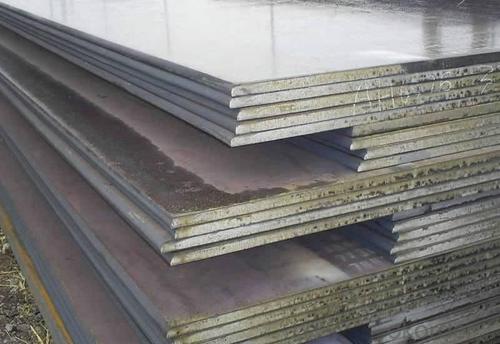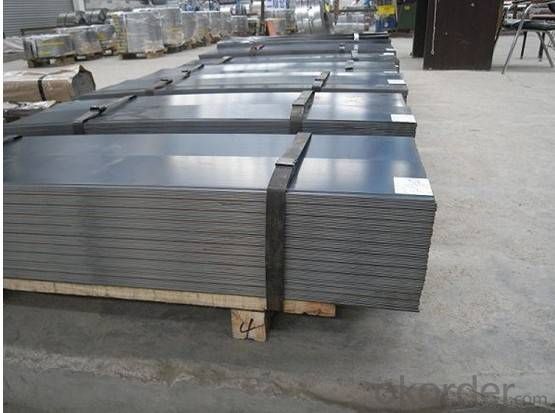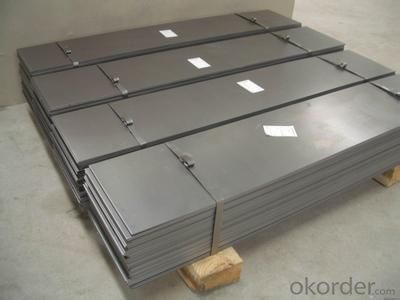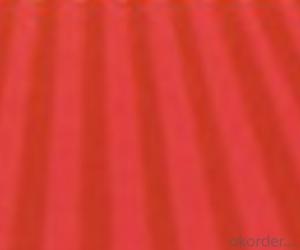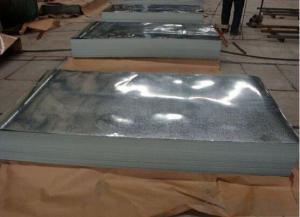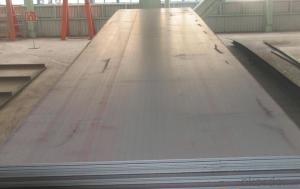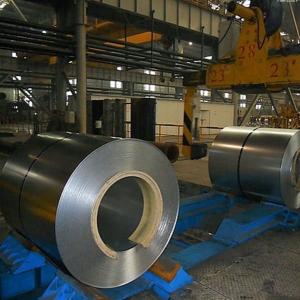Hot Rolled Steel Plate-Good Quality and Best Service
- Loading Port:
- Tianjin
- Payment Terms:
- TT or LC
- Min Order Qty:
- 200 m.t.
- Supply Capability:
- 10000 m.t./month
OKorder Service Pledge
OKorder Financial Service
You Might Also Like
1.Structure of Hot Rolled Steel Plate Description
Aluminum Ingot is with the AL as the main chemical composition. Aluminum Ingot is used for industry,such as automobile,pinning and weaving,electron broadly and so on. Aluminum Ingot has the following advantages: easy control and operation, fast melting.
2.Main Features of the Hot Rolled Steel Plate
•Hot Rolled & Annealing
•Good Quality & Fast Delivery
•Competitive Price & Nice Service
3. Hot Rolled Steel Plate Images
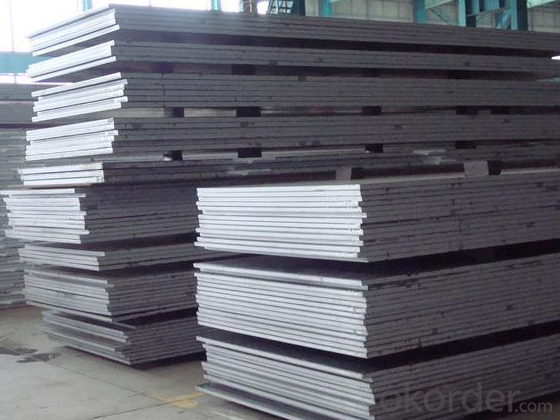
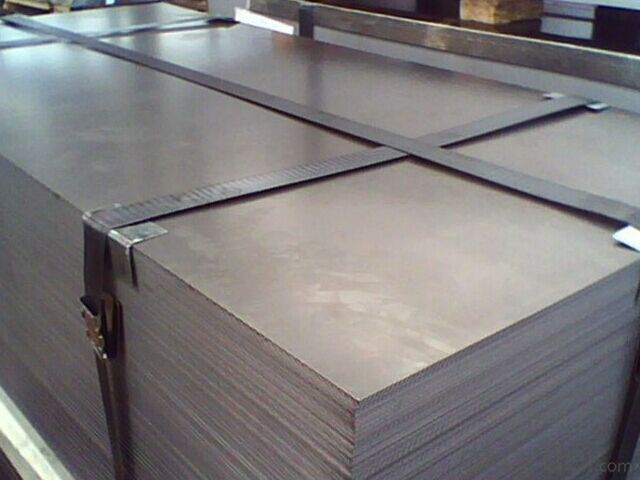
4. Hot Rolled Steel Plate Specification
Thickness | 2-100mm |
Width | 1250mm,1500mm,1800mm,2000mm.,2500mm or as required |
Length | 2000-12000mm |
Standard | AISI, ASTM, BS, DIN, GB, JIS |
Material | A36,SS400,SPCC,SPHC, Q195, Q 235,Q345 |
Tehnique | Hot rolled;cold rolled |
Payment | TT ,L/C |
Packing | Standard seaworthy packing or as required |
Market | Mild east, North/South America, Europe, Asia,Africa etc |
Certificate | BV,SGS,MTC |
Delivery time | Within 7-10 days |
5.FAQ of Hot Rolled Steel Plate
①Condition of Delivery
According to user requirements, can be Hot rolled, normalizing, tempering, normalizing and tempering, quenching and other delivery.
②Which Standard?
According to user requirements, can be delivered the following criteria: national standards, metallurgical industry standards, the United States ASTM, ASME standards, Japanese JIS, German DIN, British BS, European EN, the international ISO standards and the standards specific board and so on.
③What's the usage?
Making pipes, cold strip-welded pipes, cold-bent shaped-steel, bicycle structures, small-sized press-pieces and household decoration goods
- Q: What are the environmental considerations of using steel sheets?
- There are several environmental considerations when using steel sheets. Firstly, the production of steel sheets involves significant energy consumption, which contributes to greenhouse gas emissions. Additionally, the extraction of raw materials for steel production, such as iron ore and coal, can have negative impacts on ecosystems and biodiversity. Steel production also generates air and water pollution through the release of pollutants and waste products. However, steel sheets are highly durable and recyclable, which can help reduce the environmental impact by promoting the circular economy and reducing the need for virgin materials. Proper waste management and recycling practices are crucial to minimize the environmental footprint of using steel sheets.
- Q: How are steel sheets tested for quality?
- Steel sheets are tested for quality through a variety of methods to ensure they meet the required standards. One of the most common tests is the tensile strength test, which measures the maximum amount of stress a steel sheet can withstand before it breaks. This test is crucial as it determines the durability and reliability of the steel sheet in various applications. Another important test is the hardness test, which measures the resistance of the steel sheet to indentation or scratching. This is done using specialized tools such as a Brinell or Rockwell hardness tester. The hardness test helps determine the steel sheet's ability to withstand wear and tear, making it suitable for specific applications. The thickness of the steel sheet is also checked using a micrometer or ultrasonic thickness gauge to ensure it meets the required specifications. This is important as the thickness affects the sheet's strength and ability to withstand external forces. Furthermore, visual inspection is conducted to identify any surface defects, such as cracks, pits, or corrosion. This is done by trained professionals who carefully examine the steel sheet for any irregularities that might compromise its quality. Chemical composition analysis is another crucial test that determines the percentage of various elements present in the steel sheet. This analysis is performed using techniques like spectrometry or X-ray fluorescence to ensure the steel sheet meets the desired chemical requirements. Additionally, steel sheets may undergo tests such as impact testing, bend testing, and fatigue testing to assess their performance under specific conditions. These tests simulate real-world scenarios to ensure the steel sheet can withstand the anticipated loads and stresses it may encounter. Overall, steel sheets are rigorously tested for quality to ensure they meet the necessary standards, providing customers with reliable and durable products. These tests help manufacturers identify any potential flaws or defects, allowing them to rectify issues and deliver high-quality steel sheets to the market.
- Q: Can steel sheets be used as a decorative material?
- Yes, steel sheets can be used as a decorative material. With its sleek and modern appearance, steel sheets can add a contemporary touch to various applications, such as interior and exterior design, furniture, wall panels, and more. Additionally, steel sheets offer durability, versatility, and low maintenance, making them a popular choice for decorative purposes.
- Q: What is the maximum length of a steel sheet?
- The maximum length of a steel sheet typically depends on various factors such as the manufacturing process, transportation limitations, and customer requirements. However, in general, steel sheets can be produced in lengths ranging from a few feet to several hundred feet.
- Q: What are the advantages of using steel sheets in automotive manufacturing?
- Automotive manufacturing can benefit from the utilization of steel sheets for several reasons. Firstly, the high strength and durability of steel sheets make them well-suited for enduring the demanding conditions and stresses encountered by vehicles on the road. This remarkable strength ensures the production of safer and more dependable vehicles, as steel sheets provide a robust protective structure capable of absorbing impact energy in the event of a collision. Secondly, steel sheets possess exceptional formability, allowing them to be easily shaped and molded into various intricate designs required for automotive components. This adaptability permits the creation of precise and elaborate parts, guaranteeing a flawless fit and optimal performance. Moreover, steel sheets exhibit commendable resistance to corrosion, a crucial characteristic for automotive applications. Vehicles encounter a variety of environmental factors such as moisture, salt, and chemicals, which can lead to rust and corrosion. However, by utilizing steel sheets with protective coatings, manufacturers can ensure that their vehicles have an extended lifespan and preserve their aesthetic appeal. Additionally, steel sheets present themselves as a readily available and cost-effective alternative to other materials used in automotive manufacturing. Steel is extensively utilized in numerous industries, which has resulted in the establishment of a well-developed supply chain for steel sheets. This accessibility not only guarantees a consistent supply for automotive manufacturers but also assists in maintaining manageable production costs. Lastly, steel sheets possess excellent thermal conductivity, which is essential for effective heat dissipation in automotive applications. Vehicles generate a substantial amount of heat, particularly in the engine and exhaust systems. Steel sheets aid in efficiently transferring and dissipating this heat, preventing overheating and ensuring optimal performance. In conclusion, the advantages of utilizing steel sheets in automotive manufacturing encompass high strength and durability, exceptional formability, commendable resistance to corrosion, cost-effectiveness, and efficient heat dissipation. These factors make steel sheets the preferred choice for the production of safe, reliable, and long-lasting vehicles.
- Q: Can steel sheets be used for kitchen backsplashes?
- Yes, steel sheets can be used for kitchen backsplashes. Steel is a durable and easy-to-clean material, making it a suitable choice for a kitchen backsplash application.
- Q: Are steel sheets resistant to abrasion?
- Yes, steel sheets are generally resistant to abrasion. They are known for their durability and ability to withstand wear and tear, making them suitable for applications where abrasion resistance is required.
- Q: How do steel sheets perform in magnetic properties?
- Steel sheets are generally magnetic, meaning they can be attracted to magnets and can retain magnetism. However, the magnetic properties of steel sheets can vary depending on the specific type and composition of the steel, as well as any heat treatment or processing it has undergone.
- Q: What is the coefficient of friction of steel sheets?
- The coefficient of friction of steel sheets can vary depending on the specific surface conditions and other factors. However, on average, the coefficient of friction of steel sheets is typically around 0.6 to 0.8.
- Q: What are the different sheet metal welding techniques for steel sheets?
- Steel sheets can be joined using various sheet metal welding techniques. The most commonly used methods are as follows: 1. MIG welding, also known as Gas Metal Arc Welding (GMAW), involves the use of a continuous wire electrode to create an arc and join the steel sheets. This technique is versatile and efficient, suitable for both thin and thick sheets. 2. TIG welding, or Gas Tungsten Arc Welding (GTAW), utilizes a non-consumable tungsten electrode to create an arc and join the steel sheets. It produces high-quality welds with excellent control, making it ideal for thin or delicate sheet metal. 3. Resistance Spot Welding (RSW) involves applying pressure and passing a high electrical current through the steel sheets using two electrodes. This causes the sheets to fuse together swiftly and cost-effectively. It is commonly used in the automotive and manufacturing industries. 4. Laser Welding employs a high-energy laser beam to melt and join the steel sheets. The technique offers precise control, high welding speeds, and minimal heat input, making it suitable for thin and highly reflective materials. 5. Electron Beam Welding (EBW) utilizes a focused beam of high-velocity electrons to create a weld. It offers deep penetration and is often used for thick steel sheets or applications requiring high-quality welds. 6. Plasma Arc Welding (PAW) is similar to TIG welding but utilizes a plasma arc to create a weld. This technique provides higher welding speeds and can be used for both thick and thin steel sheets. The choice of welding technique depends on various factors such as the thickness of the steel sheets, desired weld quality, production volume, and available equipment. Each method has its own advantages and limitations.
Send your message to us
Hot Rolled Steel Plate-Good Quality and Best Service
- Loading Port:
- Tianjin
- Payment Terms:
- TT or LC
- Min Order Qty:
- 200 m.t.
- Supply Capability:
- 10000 m.t./month
OKorder Service Pledge
OKorder Financial Service
Similar products
Hot products
Hot Searches
Related keywords



